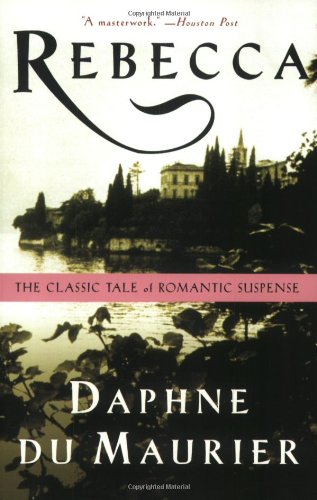All Nonfiction
- Bullying
- Books
- Academic
- Author Interviews
- Celebrity interviews
- College Articles
- College Essays
- Educator of the Year
- Heroes
- Interviews
- Memoir
- Personal Experience
- Sports
- Travel & Culture
All Opinions
- Bullying
- Current Events / Politics
- Discrimination
- Drugs / Alcohol / Smoking
- Entertainment / Celebrities
- Environment
- Love / Relationships
- Movies / Music / TV
- Pop Culture / Trends
- School / College
- Social Issues / Civics
- Spirituality / Religion
- Sports / Hobbies
All Hot Topics
- Bullying
- Community Service
- Environment
- Health
- Letters to the Editor
- Pride & Prejudice
- What Matters
- Back
Summer Guide
- Program Links
- Program Reviews
- Back
College Guide
- College Links
- College Reviews
- College Essays
- College Articles
- Back
Rebecca by Daphne Du Maurier
Love Concealed in Mystery: A Review of Daphne du Maurier’s Rebecca
Rebecca by Daphne du Maurier is a perfect representation of an English Gothic novel (The Gothic). While chronicling the fate of a nameless English companion in the early nineteen hundreds, classic elements such as a hallowed manse, a plotting hand maid, a horrendous fire, and the specter of a gorgeous wife that will not go away combine to make Rebecca a tale that is foreboding and ominous, that leaves the reader craving for more. The story is captivating and artfully crafted.
While her personality and character is so well defined, it is ironic that the reader never knows the main character’s first name. She becomes the new “Mrs. de Winter”, the lady of the manor known as Manderley when she marries Maxim. She spends the entirety of the story trying to compensate for her humble origins and lack of sophistication while attempting to reconcile herself to the first Mrs. de Winter, Rebecca, thus, the conflict.
The reader can actually feel the presence of Rebecca and it creates a delicious tension throughout the entire novel. The juxtaposition of Rebecca and the new Mrs. de Winter is wonderfully played. This continuing tension is foreshadowed when Maxim lends the soon to be Mrs. de Winter a book of poems, while still in Monte Carlo. She finds an inscription on the title page, “Max from Rebecca” and it instantly haunts her. The demon whispers to her “Go on”, “open the title-page, that’s what you want to do, isn’t it?” (Du Maurier 57). She succumbs and remarks about the inscription, “How alive was her writing though, how full of force. Those curious, sloping letters. The blob of ink. Done yesterday. It was just as if it had been written yesterday” (Du Maurier 57). Already Rebecca is a force to be dealt with. The force increases once the new Mrs. de Winter reaches Manderley. When she braves entering Rebecca’s old bedroom, the feeling of being an “uninvited guest” (Du Maurier 165) is pervasive. She finds the room as if it is still occupied, picks up the slippers by the bed and “was aware of a growing sense of horror, of horror turning to despair. I touched the quilt on the bed, traced with my fingers the monogram on the nightdress case, R de W, interwoven and interlaced” (Du Maurier 166). “Interwoven and interlaced”, just like the two Mrs. de Winter’s lives.
Du Maurier uses the literary element of setting brilliantly to support the gothic tone of this story. The newly married couple arrives at Manderley in early May. After a long and winding serpent like drive, the new Mrs. de Winter sees the Manderley of her “picture post-card long ago. A thing of grace and beauty, exquisite and faultless, lovelier even than I had ever dreamed” (Du Maurier 65). Manderley is engulfed by gorgeous, fragrant foliage. As she and Maxim are walking the grounds, he leads her through the woods to a valley, “Happy Valley”. As the couple continues down into the valley they enter the little narrow cove, with the sea just beyond. Mrs. de Winter falls under the “spell of Happy Valley”, “This at last was the core of Manderley, the Manderley I would know and learn to love” (Du Maurier 109). Maxim describes the contrast of the valley with the unexpected cove as “a shock”, “no one ever expects it. The contrast is too sudden, it almost hurts” (Du Maurier 109). Many setting details evoke the gothic; massive, old, extreme landscapes and beauty that causes pain. .
The tension and romance coupled with two amazing plot twists culminate in an extraordinary read. Rebecca by Daphne du Maurier not only fulfills the author’s purpose of telling an amazing Gothic love story, but surpasses it. It is deeply satisfying book that leaves the reader saddened when it is over, as if missing a lost best friend.
Works Cited
Du Maurier, Daphne. Rebecca. London: Guild Publ., 1978. Print.
"The Gothic." The Gothic. The Gothic Experience, 24 Oct. 2002. Web. 20 May 2014. <http://academic.brooklyn.cuny.edu/english/melani/gothic/gothic.html>.
Similar Articles
JOIN THE DISCUSSION
This article has 0 comments.

